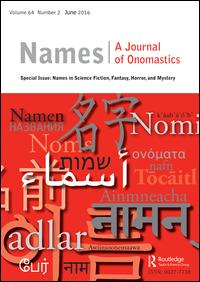Published 2011-12-01
Copyright (c) 2011 Maney Publishing

This work is licensed under a Creative Commons Attribution 4.0 International License.
Abstract
AbstractThe term “Chinese” can refer to an ethnicity, a group of people, or language(s). This conflation makes disentanglement especially difficult, yet not disambiguating perpetuates an oversimplification of a nation, languages, peoples, and cultures. While this blanket term collapses plurality into a monolithic entity, the converse seems to hold when looking at Romanized naming practices of Chinese Americans. The alphabetic rendition of Chinese American names draws relatively clear boundaries of country of origin and general time of arrival to the United States. This paper problematizes the term “Chinese” and looks at the Chineses like Cantonese and Hoisan-wa, which have long overlooked histories in the United States and hold critical clues to disambiguating the cultural and linguistic pluralities of what many would lump together as an immutable term. These findings have implications for using this naming phenomenon to raise linguistic awareness and for the teaching of Chinese American history.
References
- Alim, H. Samy. 2007. “Critical Hip-Hop Language Pedagogies: Combat, Consciousness, and the Cultural Politics of Communication.” Journal of Language, Identity, and Education 6(2): 161–176.
- Blench, Roger. 2006. “Lateral Fricatives in Africa and Worldwide: Explorations in the Prehistory of Phonemes.” Unpublished manuscript.
- Burt, Susan Meredith. 2009. “Naming, Re-Naming and Self-Naming Among Hmong-Americans.” Names 57(4): 236–245.
- Chan, Marjorie K.M., and Douglas W. Lee. 1981. “Chinatown Chinese: A Linguistic and Historical Re-evaluation.” Amerasia Journal 8(1): 111–131.
- Chang, Iris. 2003. The Chinese in America: A Narrative History. New York: Viking Adult.
- Cheng, Teresa. 1973. “The Phonology of Taishan.” Journal of Chinese Linguistics 1(2): 256–322.
- Irvine, Judith, and Susan Gal. 2000. “Language Ideology and Linguistic Differentiation.” Regimes of Language: Ideologies, Polities, and Identities. Ed. P. Kroskrity. Santa Fe: School of American Research Press,35–83.
- Keeler, Lauren. 2008. “Linguistic Reconstruction and the Construction of Nationalist-Era Chinese Linguistics.” Language and Communication 28(4): 344–362.
- Kim, Richard I. 2008. “California Chinese Pidgin English and its Historical Connections: Preliminary Remarks.” Journal of Pidgin and Creole Languages 23(2): 329–244.
- Kingston, Maxine Hong. 1989. Woman Warrior: Memoirs of a Girlhood Among Ghosts. New York: Vintage.
- Kroskrity, Paul. 2001. “Language Ideologies.” A Companion to Linguistic Anthropology. Ed. A. Duranti. Malden: Wiley Blackwell, 496–517.
- Kuong, Io-Kei Joaquim. 2008. “Yes/no Question Particles Revisited: The Grammatical Functions of mo4, mei, and maa3.” Proceedings of the Twentieth North American Conference on Chinese Linguistics (NAACL-20). Ed. M. Chan. GSIL: University of Southern California,715–733.
- Lau, Chun Fat. 2005. “A Dialect Murders Another Dialect: The Case of Hakka in Hong Kong.” International Journal of the Sociology of Language 173: 23–35.
- Lee, William Poy. 2007. The Eighth Promise: An American Son’s Tribute to his Toisanese Mother. New York: Rodale.
- Lee-Wong, Song Mei. 1994. “Address Forms in Modern China: Changing Ideologies and Shifting Semantics.” Linguistics: 32: 299–423.
- Leung, Genevieve. 2009. “‘CHINESE’ Confusion: A Look at the Use of ‘Cantonese’ and ‘Mandarin’ in Newspapers.” Unpublished term paper,University of Pennsylvania, Philadelphia, PA.
- Li, Chris Wen-Chao. 2004. “Conflicting Notions of Language Purity: The Interplay of Archaising, Ethnographic, Reformist, Elitist,and Xenophobic Purism in the Perception of Standard Chinese.” Language and Communication 24(2): 97–133.
- Li, David C. S. 1997. “Borrowed Identity: Signaling Involvement with a Western Name.” Journal of Pragmatics 28(4): 487–513.
- Louie, David Wong. 2000. The Barbarians are Coming. New York: G.P. Putnam’s Sons.
- Louie, Emma Woo. 1998. Chinese American Names: Tradition and Transition. Jefferson, NC: McFarlan and Company.
- Mair, Victor H. 1991. “What is a Chinese ‘Dialect/Topolect’? Reflections on Some Key Sino-English Linguistic Terms.” Sino-Platonic Papers 29: 1–31.
- McCoy, John. 1966. “Szeyap Data for a First Approximation of Proto-Cantonese.” Unpublished PhD dissertation. Ithaca, NY: Cornell University.
- McDannold, Thomas A. 1994. “Chinese Placenames and Their Significance.” Origins and Destinations: 41 Essays on Chinese America. Los Angeles: Chinese Historical Society of Southern California.
- Nilsen, Alleen Pace and Don L.F. Nilsen. 2008. “Guest Editorial.” Names 56(1): 3–5.
- Ng, Fae Myenne. 1993. Bone. Hyperion: New York.
- Ramsey, S. Robert. 1987. The Languages of China. Princeton: Princeton University Press.
- Roy, John. 1987. The Linguistic and Sociolinguistic Position of Black English and the Issue of Bidialectalism in Education. Childhood Bilingualism: Aspects of Linguistic, Cognitive and Social Development. Ed. P. Homel, M. Palij, & D. Aaronson. Hillsdale, NJ: Lawrence Erlbaum Associates.
- Silverstein, Michael. 1976. “Shifters, Linguistic Categories and Cultural Description.” Meaning in Anthropology. Ed. K. Basso and H. Selby. Albuquerque: University of New Mexico Press,11–55.
- Stubbs, Michael. 1998. Text and Corpus Analyses. Malden, MA: Blackwell Publishers.
- Wiley, Terrence. G. 2008. “Chinese ‘Dialect’ Speakers as Heritage Language Learners.” Heritage Language Education: A New Field Emerging. Ed. D. Brinton, O. Kagan, and S. Bauckus. New York: Routledge, 91–106.
- Wong, Andrew and Qing Zhang. 2001. “The Linguistic Construction of the Tongzhi Community.” Journal of Linguistic Anthropology 10(2): 248–278.
- Yep, Laurence. 1991. The Lost Garden. New York: Simon & Schuster.
- Yue-Hashimoto, Anne O. 2005. The Dancun Dialect of Taishan. Hong Kong: Language Information Sciences Research Center,City University of Hong Kong.

